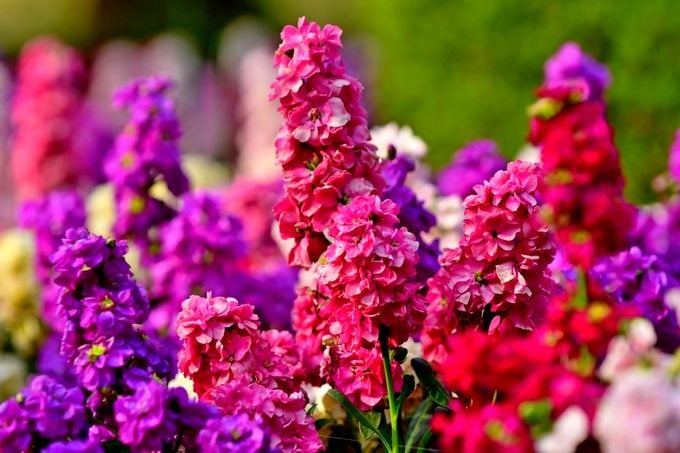Stock Flower Care and Growing Tips
Updated: May 08, 2024
Welcome the scent of spicy stock flower to your cool season garden. These blooms are fragrant, vibrant and great for bouquets.
On This Page
How to Grow Stock Flowers

- Common name: Stock flower, Brompton stock
- Scientific name: Matthiola incana
- Hardiness zones: 7 to 10
- Light needs: Full sun to partial shade
- Watering needs: Average, keep soil consistently moist but not waterlogged
- Preferred soil: well-drained, fertile, pH of 6.0 to 7.5
- Size: 10 to 36 inches tall, 6 to 18 inches wide
- Flower colors: white, pink, purple, lavender, red, yellow, apricot, blue, rose pink, bicolor or multicolor
- Attracts: Bees and butterflies
Spiky, colorful stock flowers are relatively easy to grow and low-maintenance once established, making them a good choice for both new and experienced gardeners. But they do require specific conditions.
“Stock thrive in fertile, well-drained soil,” says Dr. Christine Coker, horticulturist and professor at Mississippi State University. “Good plant nutrition is necessary for better quality; however, high levels of nitrogen can cause weak stems.” It is always helpful to get a soil test and make necessary amendments before planting.
When and Where to Plant Stock Flowers
Plant stock flowers in full sun in cooler zones or dappled sun in hotter and drier climates. Depending on your preferences, you can grow them from seeds or potted plants. “Starting from seeds gives you a wider variety of options, while starting with potted plants can give you a head start in the growing process,” says Laura Root a horticulturist at Park Seed.
Transplant seedlings or potted plants in early spring, after the last frost, with plenty of space to grow. To encourage longer stems for cut flowers, Christine recommends spacing them on six-inch centers. You can also plant seeds in the fall in mild climates for early spring blooms.
“They do well in cool weather and are typically grown as annuals,” says Laura. “However, in warmer climates, they may reseed and act as biennials. They also make great container plants, so you can add them to your garden bed or place them on a patio or balcony.”
Stock Flower Problems
To prevent wilting and stress, stock flowers need consistent moisture levels, and never let them dry out. Use a trellis or other support for taller varieties and regularly deadhead them, removing spent blooms to encourage new growth and prolong blooming.
As for pitfalls, watch out for aphids, thrips and fungal diseases.
Stock Flower Benefits
With their spiky stalks and variety of bright colors, stock flowers make both your garden and home décor come alive. They’re ideal for bouquets, centerpieces, focal flowers and corsages since they last up to two weeks after being cut.
“Stock flowers are renowned for their delightful fragrance, which is often described as a mix of cloves, cinnamon and vanilla,” says Laura. “This sweet and spicy scent makes them popular choices for perfumes and potpourri.”
They can also be used as a garnish, says Christine, though the flowers are bitter. When springtime temperatures begin to rise, they stop producing flowers.
Stock Flower Meaning
They also come rooted in tradition. “In the language of flowers, stock flowers symbolize lasting beauty and a happy life,” says Laura. “They are often included in bouquets for weddings and other celebrations.”
Do Stock Flowers Attract Pollinators?
Some varieties release their fragrance in the evening, attracting nocturnal pollinators like moths and bats. During the day, their bright blooms also help butterflies, bees and other important pollinators.
“By providing a food source for these pollinators, stock flowers can help support a healthy ecosystem in your garden,” says Laura. “Additionally, the flowers themselves can serve as shelter for small insects and other wildlife. Adding stock flowers to your garden can contribute to a more diverse and vibrant environment.”
Stock Flower Varieties

“For cut flower use, I am particularly fond of the Katz Series which is available in apricot, blue, pink, white, purple, rose pink, rose and yellow,” says Christine.
Laura’s top pick is Hot Cakes, an interesting variety known for vibrant and eye-catching blooms in bold colors including deep purple and bright pink. “It produces large, double flowers that add a pop of color to garden beds or floral arrangements,” she says. “They perform best in cool weather and give an excellent fragrance in early spring.”
About the Experts
Laura Root is a horticulturist and senior product manager at Park Seed. She has 12 years of experience in the green industry and holds a degree in environmental horticulture from Virginia Tech University. Plants are her passion, but her joy especially comes from sharing her knowledge with others.
Dr. Christine E.H. Coker is a research and Extension professor of urban horticulture at Mississippi State University’s Coastal Research and Extension Center Beaumont Horticultural Unit. She has more than 20 years of experience sharing her love of plants with gardeners of all skill levels.
Why Trust Us?
For nearly 30 years, Birds & Blooms, a Trusted Media Brand, has been inspiring readers to have a lifelong love of birding, gardening and nature. We are the #1 bird and garden magazine in North America and a trusted online resource for over 15 million outdoor enthusiasts annually. Our library of thousands of informative articles and how-tos has been written by trusted journalists and fact-checked by bird and garden experts for accuracy. In addition to our staff of experienced gardeners and bird-watchers, we hire individuals who have years of education and hands-on experience with birding, bird feeding, gardening, butterflies, bugs and more. Learn more about Birds & Blooms, our field editor program, and our submission guidelines.




















